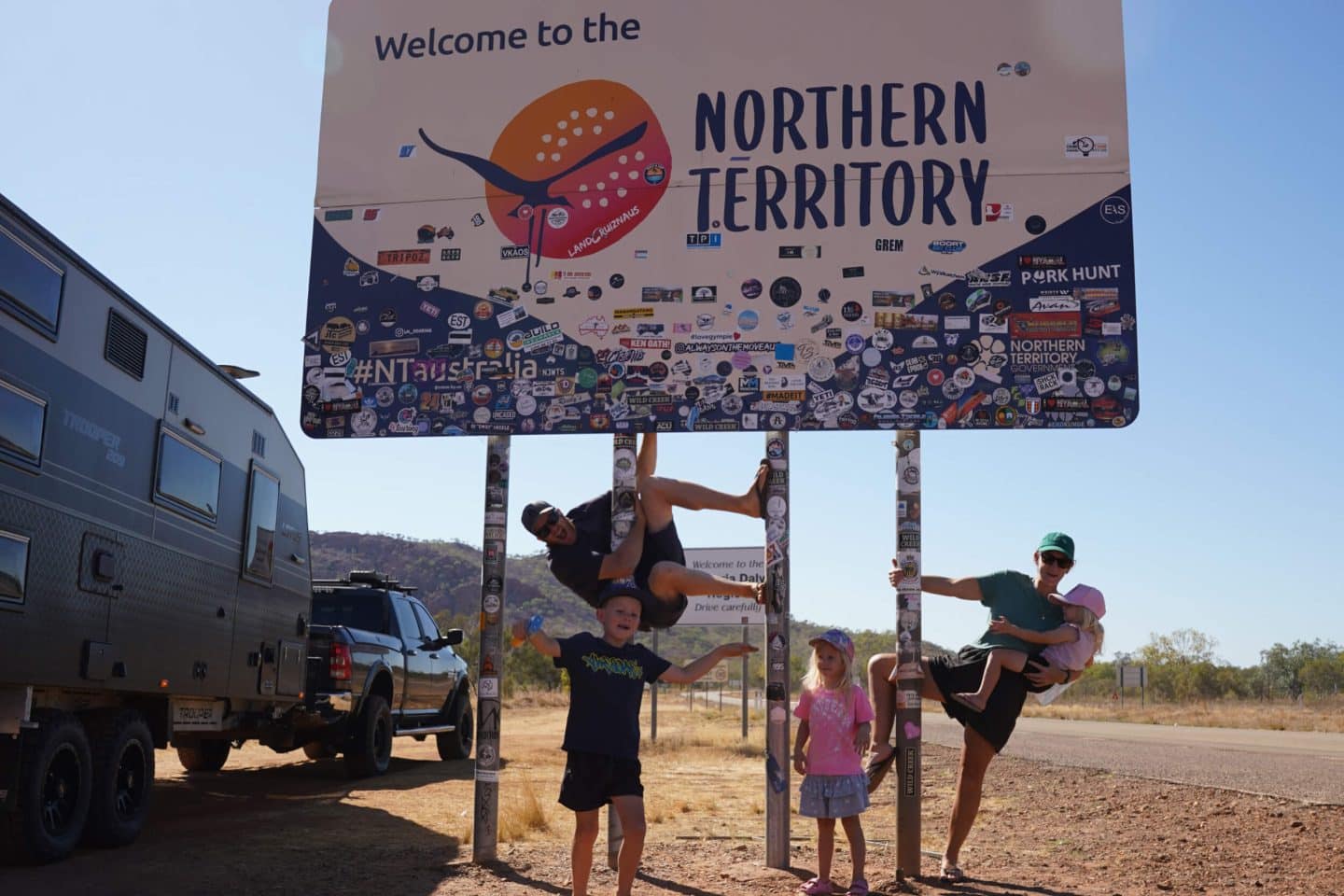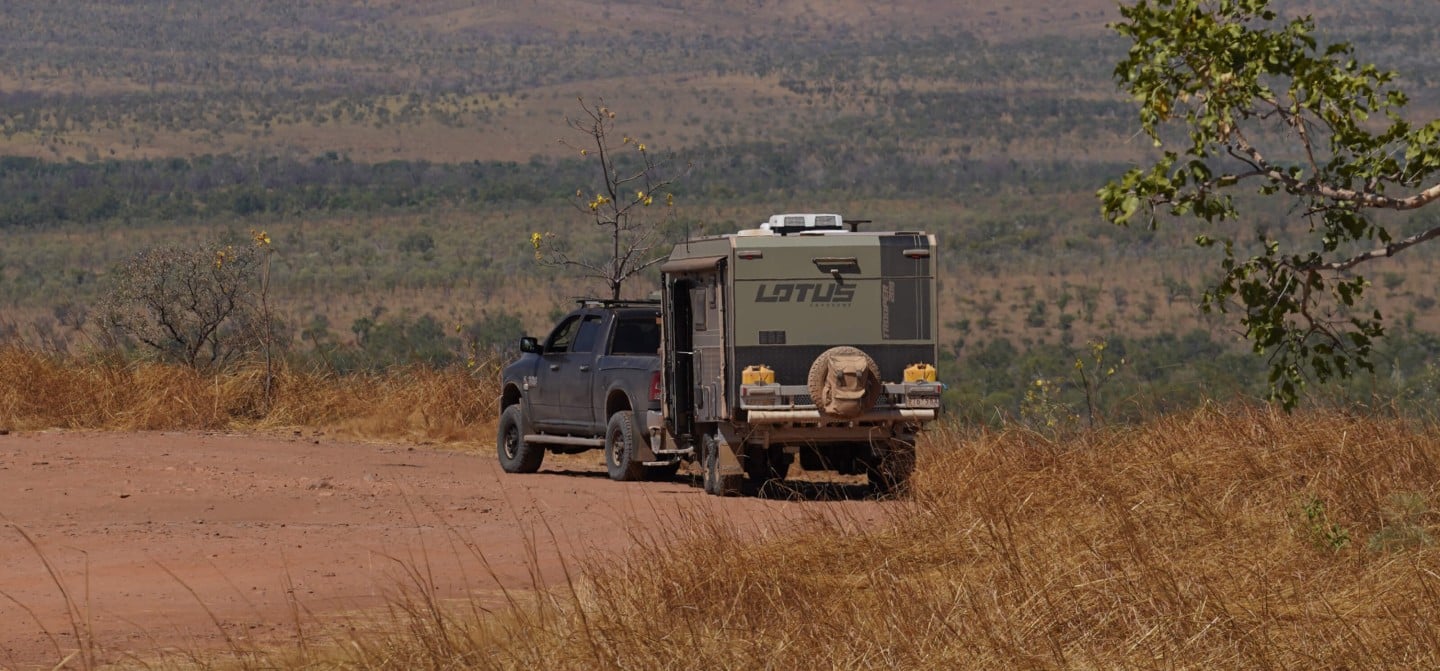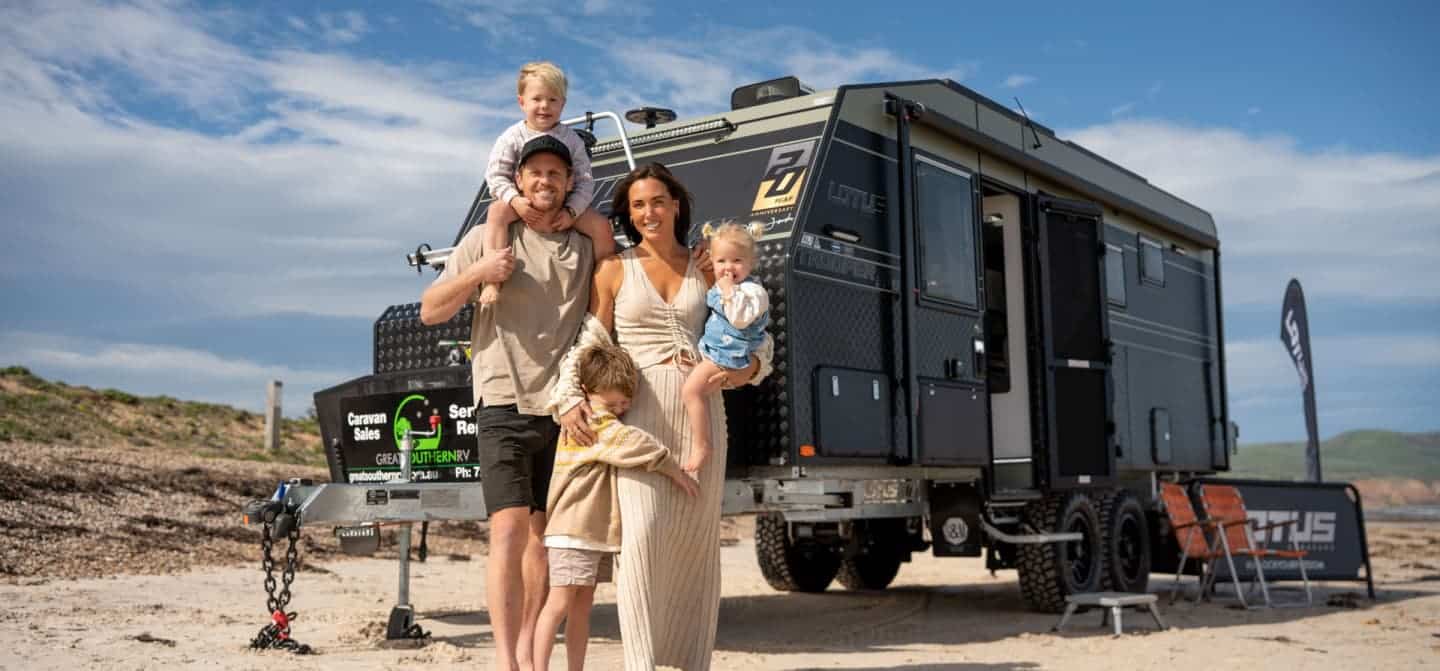THE GIBB GUIDE
Written by Olly King of the All Over Roamers
Hey, we are Amy and Oliver, with our three kids Kohen, Tully, and Romily. We have been on the road full-time since April 2021. We both love everything outdoors and travelling has always been a big part of our lives. We believe that time with our kids is precious and have made it a priority to spend as much time with them before they grow up and start living their own lives.

Our 13-day Itinerary for travelling the Gibb River Road with Kids
The Gibb River Road is one of Australia’s best dirt road adventures. The 660 km stretch of road is home to some incredible landscapes, hiking trails, waterfalls, swimming holes, outback stations, and amazing camping spots. The road itself runs between the WA towns of Derby and heads northeast to Kununurra and is mostly gravel, with a few short sections of bitumen, the conditions of the gravel sections change constantly and can get pretty rough at times, so some vehicle preparation beforehand is a good idea.
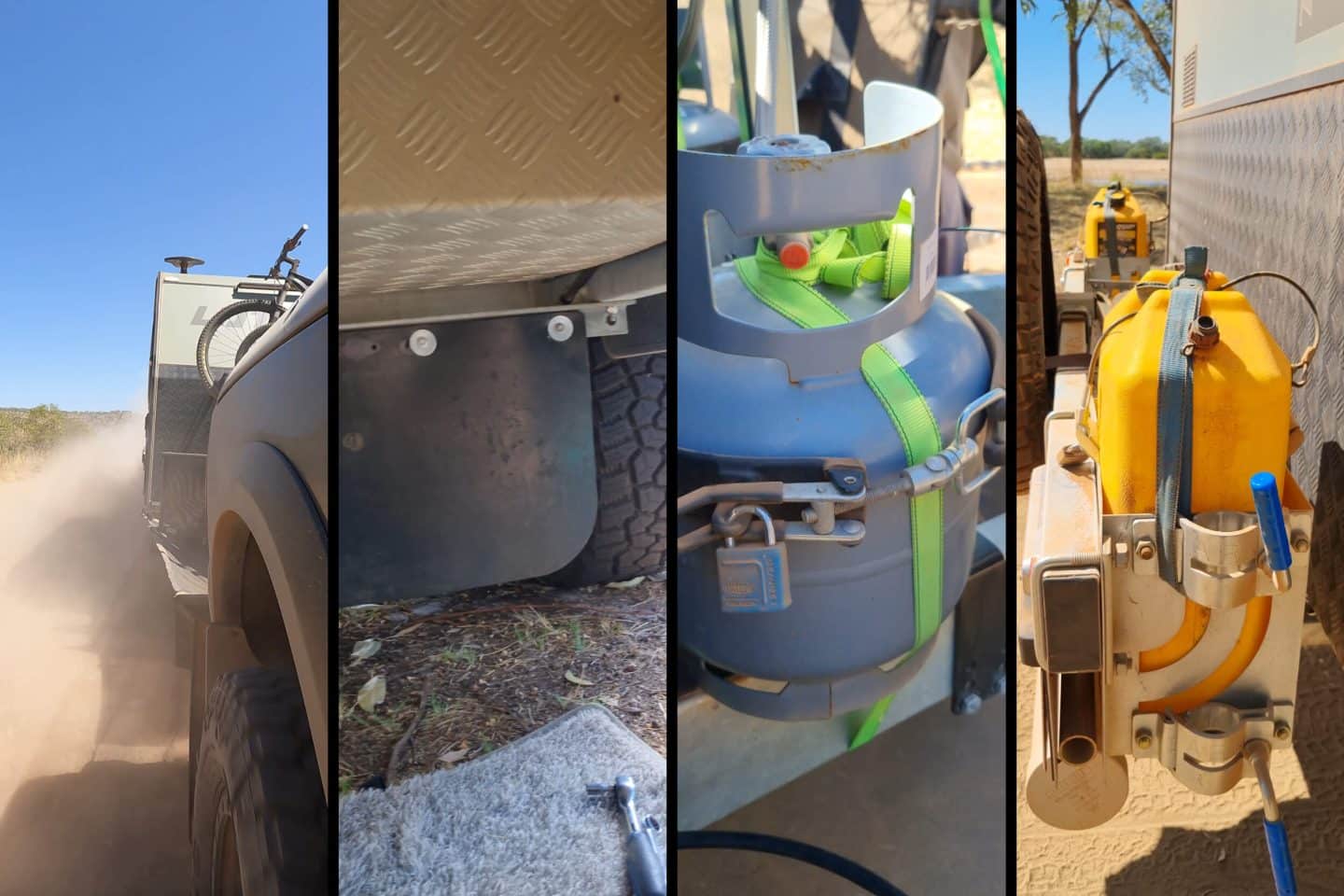
The Prep
Each vehicle and camping setup is different, but this is what we did to help protect our setup.
- Extra Stone Protection: We fitted a stone stomper between the ute and the van, and also some extra mud flaps in front of the van suspension.
- Protect the Pipework: A few bits of pool noodle around a couple of exposed PVC pipe underneath, our van has full underbody checker plate guards so not a lot to worry about.
- Tie down Gas Bottles and Jerry Cans: Corrugations are a killer for anything that’s not bolted down, so even though the gas bottles are clamped in tight, they are not secured down. So a tie down around the bottle and under the chassis got them nice and secure. Also, our full jerry cans on the back of the van received the same treatment. Overkill maybe? But a simple job to prevent a potential problem.
- Stock up with Food and Water: Take enough food for a couple of weeks; food on the Gibb is expensive and in short supply in most places. We left with our water tanks full, and 55l of water in a bladder in the ute, we found this to be way more than what we needed due to all the stations having fresh water taps available for filling up. But you’re better off having too much than not enough..within reason.
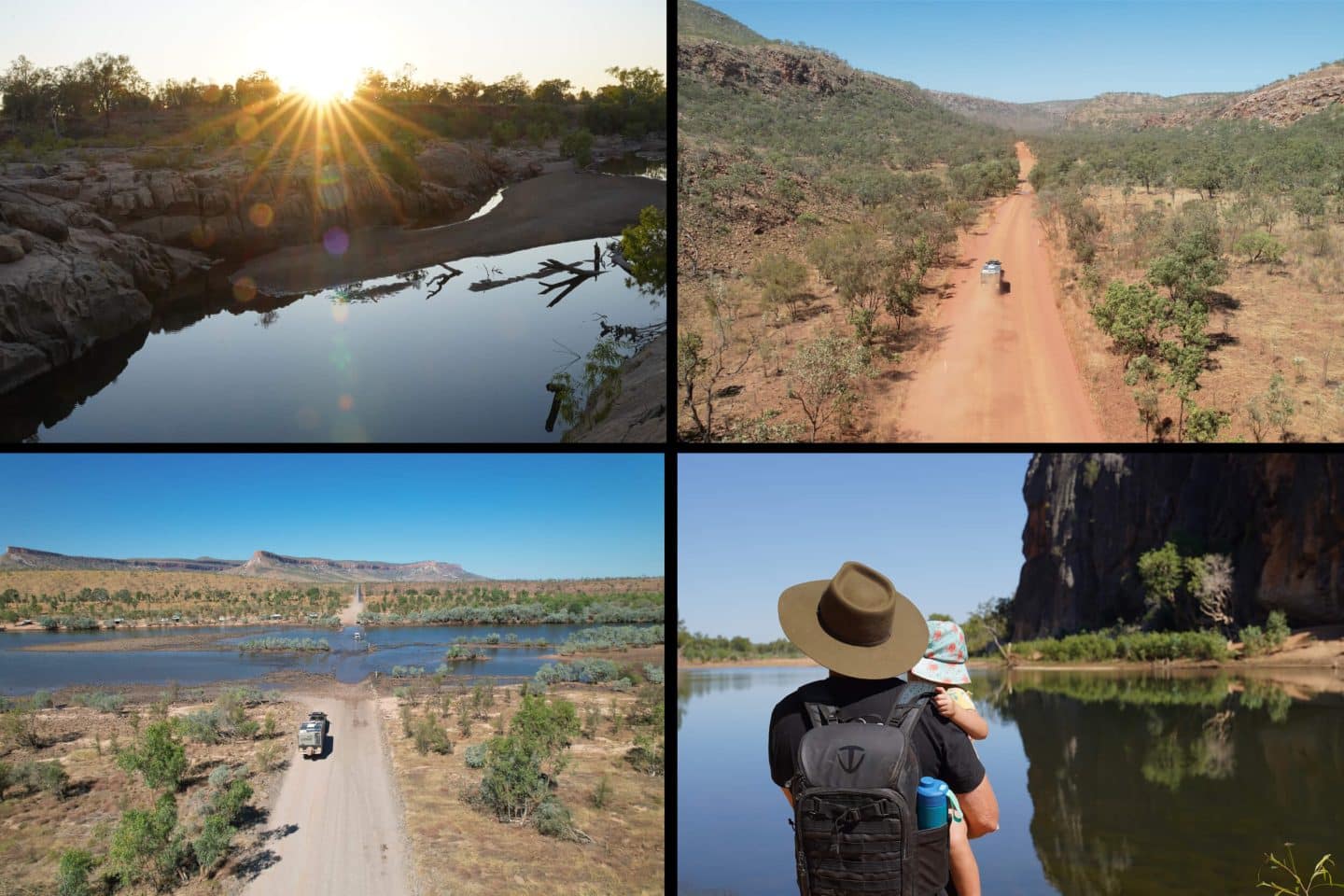
Extra tips before you leave
- Diesel can be purchased from most of the stations along the Gibb, as well as Imintji Roadhouse, Mt Barnett Roadhouse & Drysdale River Homestead. Petrol is a bit harder to find but can be purchased from Mt Barnett Roadhouse, Drysdale River Homestead and El Questro Station.
- What tyre pressure you running? This question is asked frequently amongst Gibb travellers, and the most common number we heard was between 28 – 30 psi cold. With our Ram 2500 and Lotus Caravans Trooper, we ran 28 psi cold on both the ute and van. This was just enough to absorb the corrugations nicely without exposing too much sidewall.
Our 13-day itinerary
Day 1 – Derby to Lennard River Crossing (125 km)
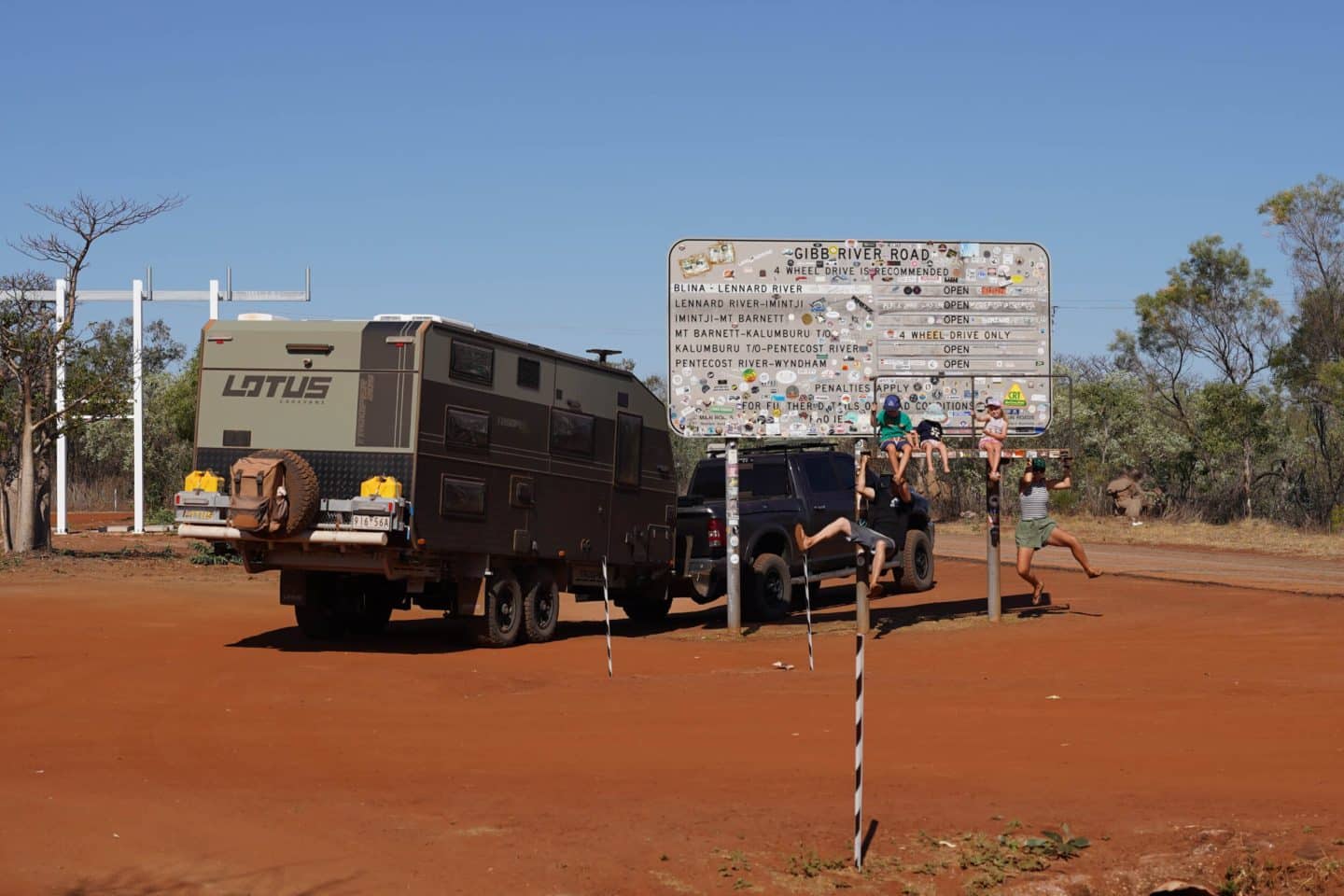
Leaving Derby fully loaded, you can’t drive past the famous Gibb River Road sign without stopping for a few photos.. because, did you even do ‘The Gibb’ if you didn’t get ‘that’ photo??
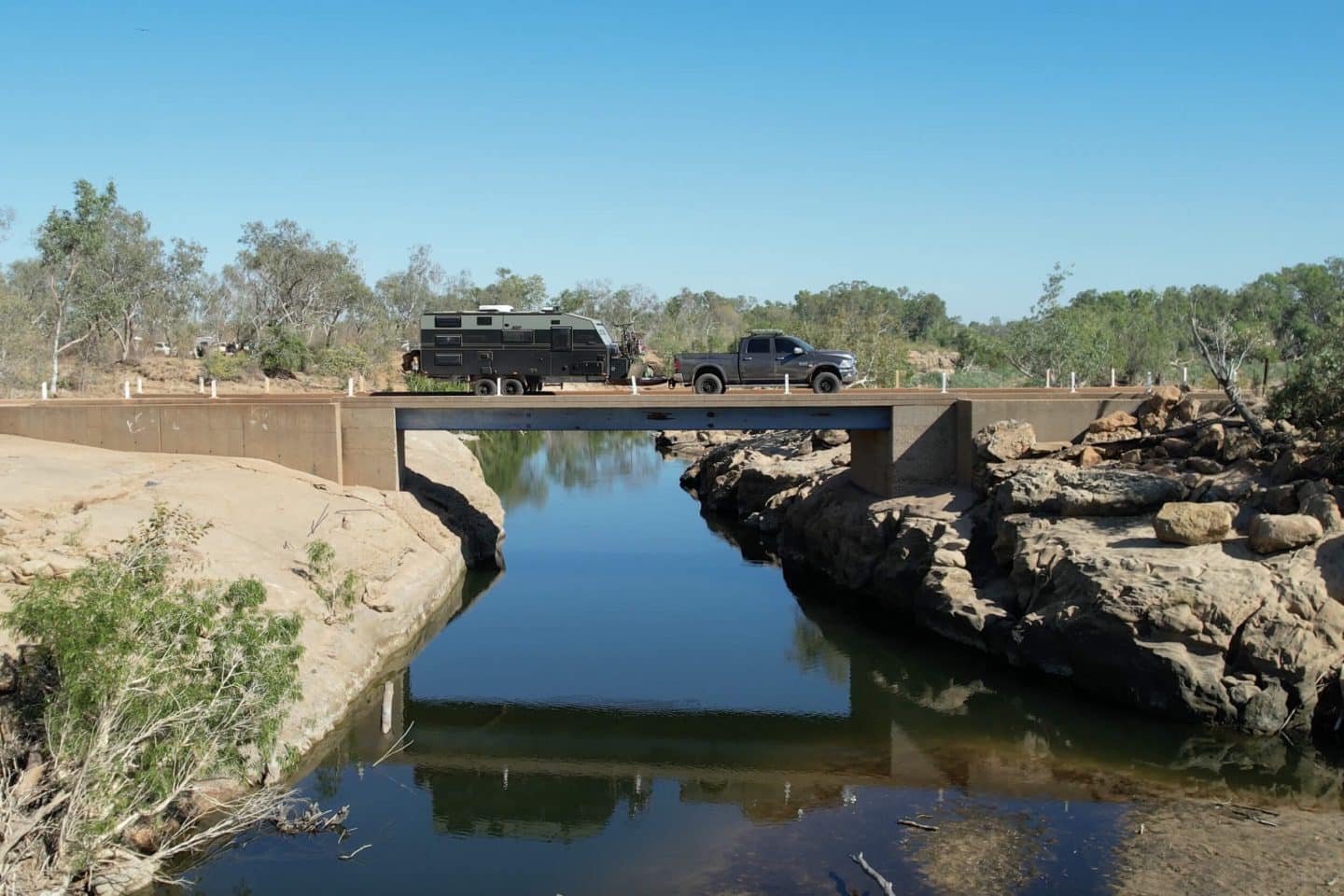
After a short 125 km of bitumen road, you arrive at Lennard River Crossing, a free camp just after the Windjana Gorge turn-off. If you get here early you will have the pick of the sites, but if you are like us and turn up at 4 pm, you grab whatever is available! This will serve as a base for two nights while you explore Windjana Gorge and Tunnel Creek.
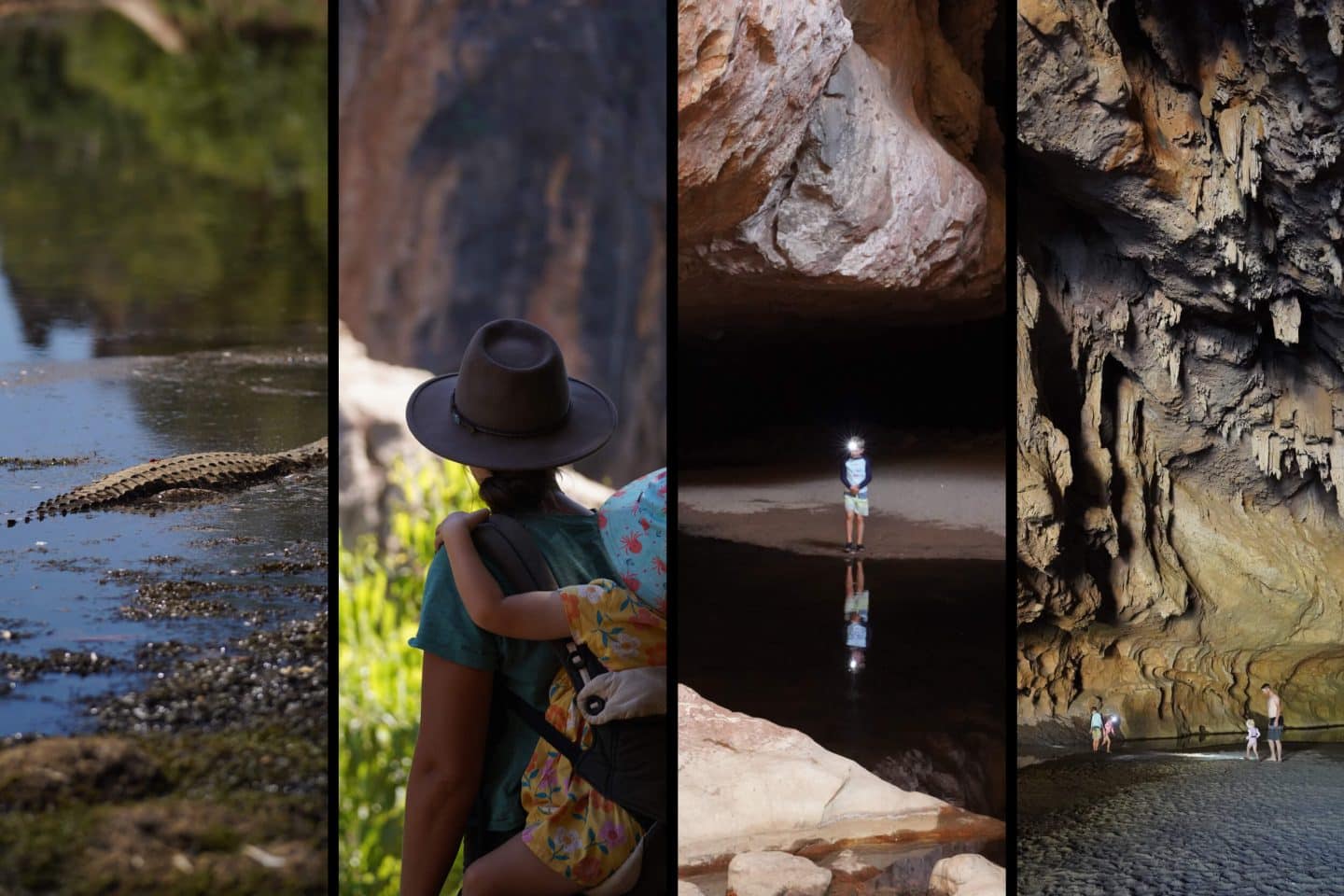
Day 2 – Day trip to Windjana Gorge, Tunnel Creek (115 km return)
Pack lunch, plenty of water, togs and head torches.
Head down Fairfield Leopold Downs Road for 22 km; the road was heavily corrugated so we let our tyres down to 28 psi. Windjana Gorge is a National Park so entry fees apply.
The 1 km walk into the gorge is easy but the scenery is spectacular. Here, you are guaranteed to see a range of wildlife, including a few freshwater crocodiles! There is not much shade, so plan this walk at the start of the day, or in the afternoon. Sunsets here are a sight to behold!
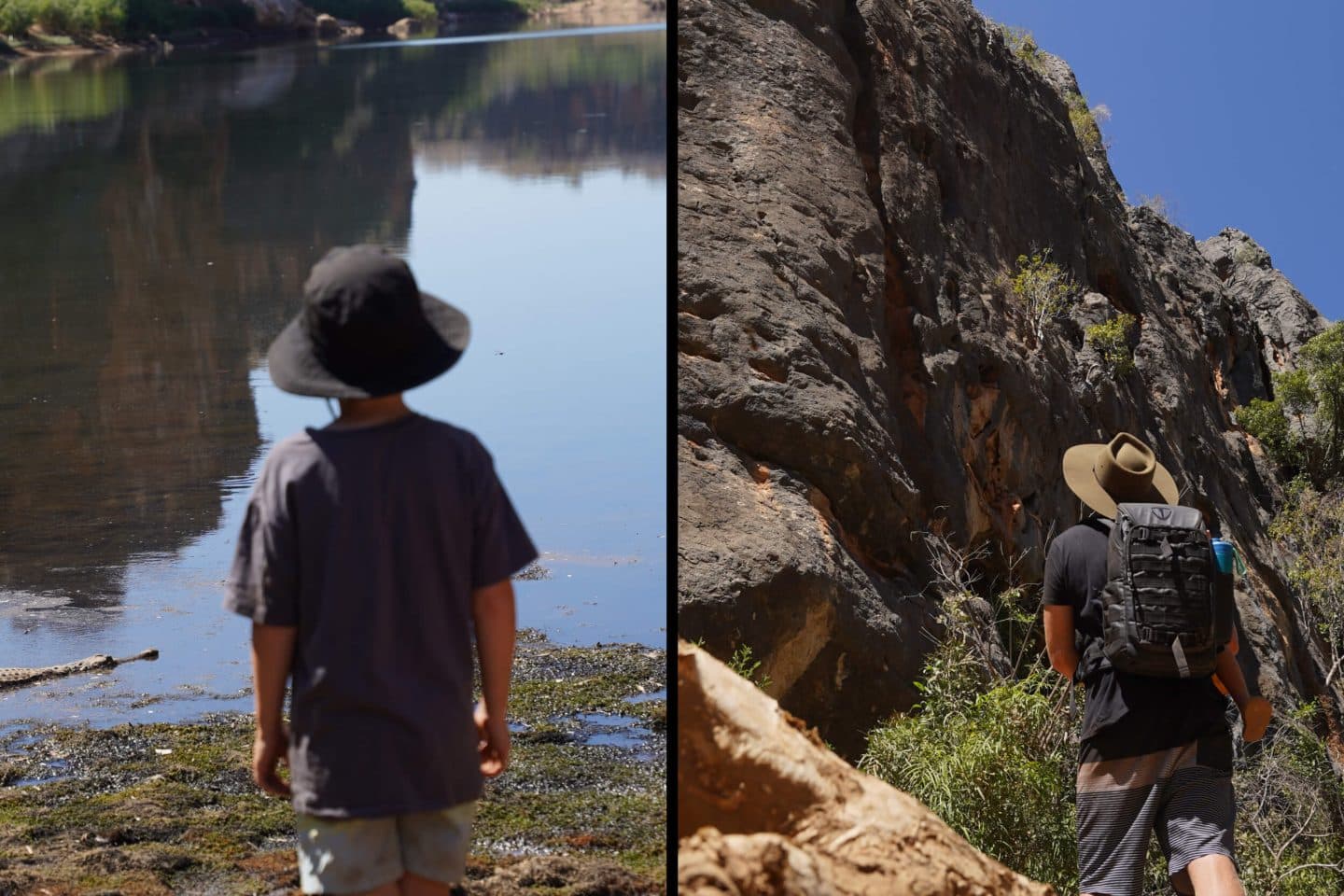
Back on the corrugated road for 36 km, head to Tunnel Creek. This is a good spot for lunch as there are a bunch of tables in the shade. It’s a short walk from the car park to the start of the tunnel, and there is plenty of Aboriginal rock art so keep a lookout.
The walk starts in a large open cave-like area, then as you keep walking it, the roof gets lower and the light runs out – but you packed your head torch, right? At about halfway you will have to walk through some water, it was up to my chest with soft mud underneath. Keep a lookout for freshies too as they are known to hang out in here.. we saw one after the water crossing. It’s an awesome feeling to reach daylight at the other end. The rock art is impressive so make sure you look around all the walls..also keep an eye out for the bonus cave system in the middle!
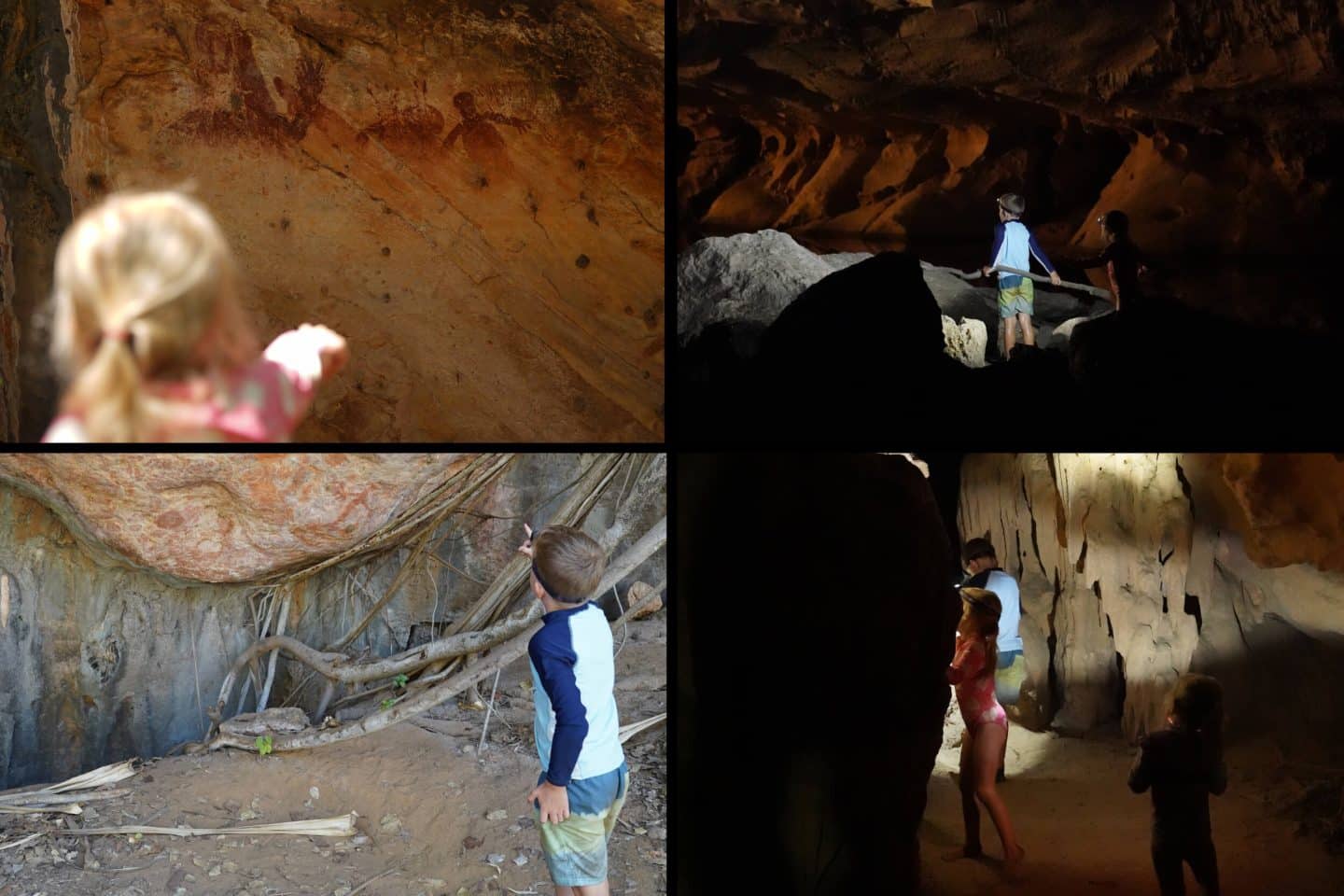
Day 3 – Lennard River to Mount Hart Wilderness Lodge (114 km)
The bridge at Lennard River marks the start of the gravel, so leave camp with tyres deflated. It’s not long until the scenery changes dramatically, Queen Victoria’s head on the Napier Ranges is like a gateway to the adventures ahead. The road into Mount Hart is only 50 km, but it’s slow going, luckily the scenery is nice.
The camping area is mostly open with plenty of trees for shade alongside a river. Swimming is encouraged and there’s also a rope swing and a kayak to paddle around in. Set yourself up and keep an eye out for the sunset cocktail shuttle for a lift to the lodge. Arriving at the lodge you will be welcomed with the sounds of live music and you’d be mad if you didn’t order a pizza and a few cocktails!
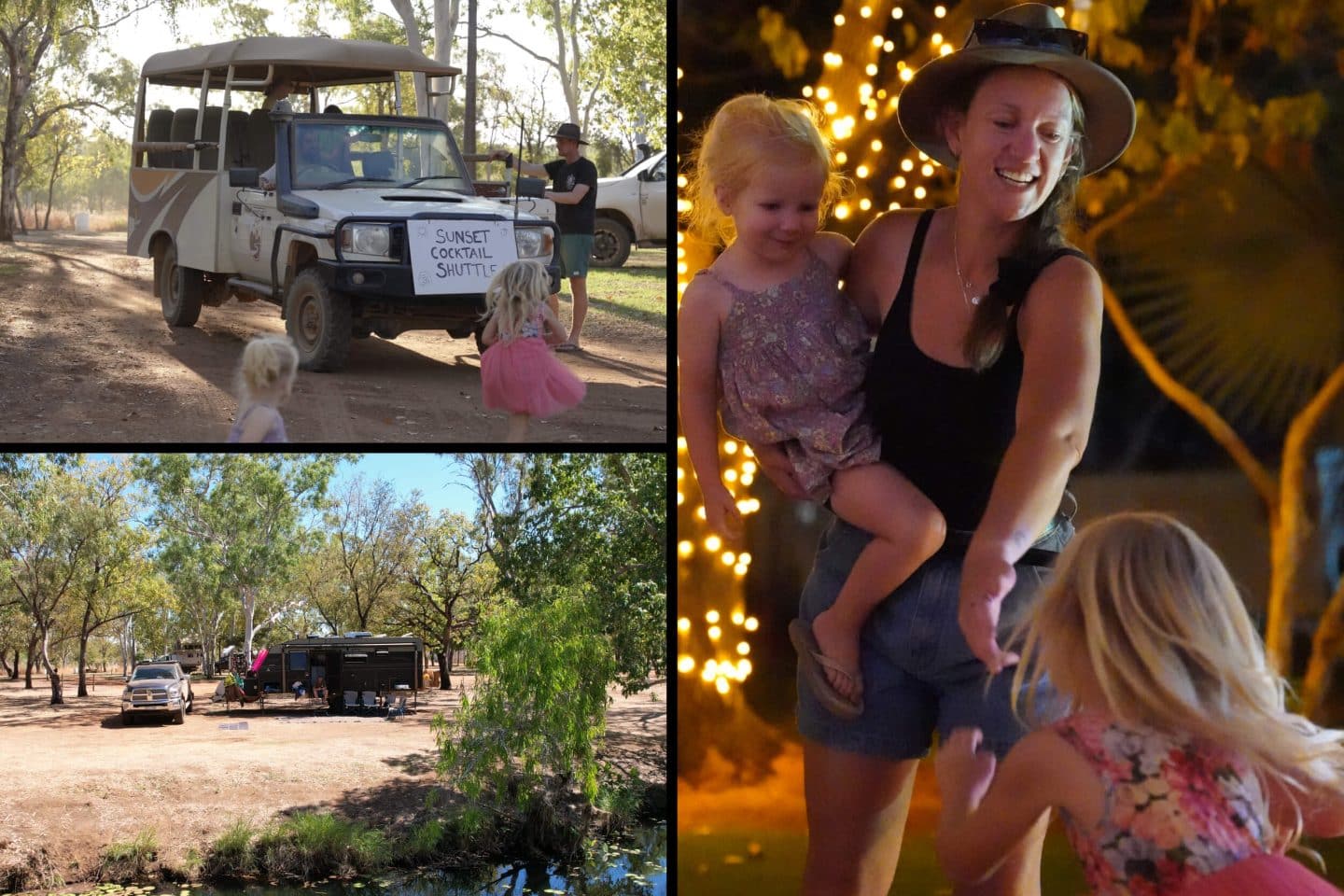
Day 4 – Dolerite Gorge and Barkers Pool
Just a short drive from camp you will find the start of the Dolerite Gorge walk. The trail follows the river upstream to a large swimming hole, with plenty of spots for a dip along the way. We loved the spa pool about halfway with water spilling over into a small plunge pool. Barkers pool is an oasis fed by spring water – too inviting not to swim. Head back to camp for a relaxing afternoon by the river.

Day 5 – Mount Hart to Bell Gorge (108 km)
Heading off in the morning with fuel and water tanks full (both available at the lodge) make the slow but stunning journey out to the main road. A short distance down the Gibb is a free camp called March Fly Glen; drop the van off here and get back on the road to Bell Gorge.
Bell Gorge is probably the most popular waterfall on the Gibb, and when you get there you will understand why! It’s an easy downhill walk to the top of the falls, but venturing down to the bottom requires a slippery river crossing and a challenging track down the rocky hillside.. but trust me, it’s absolutely worth it! We spent the afternoon here and enjoyed it mostly to ourselves.
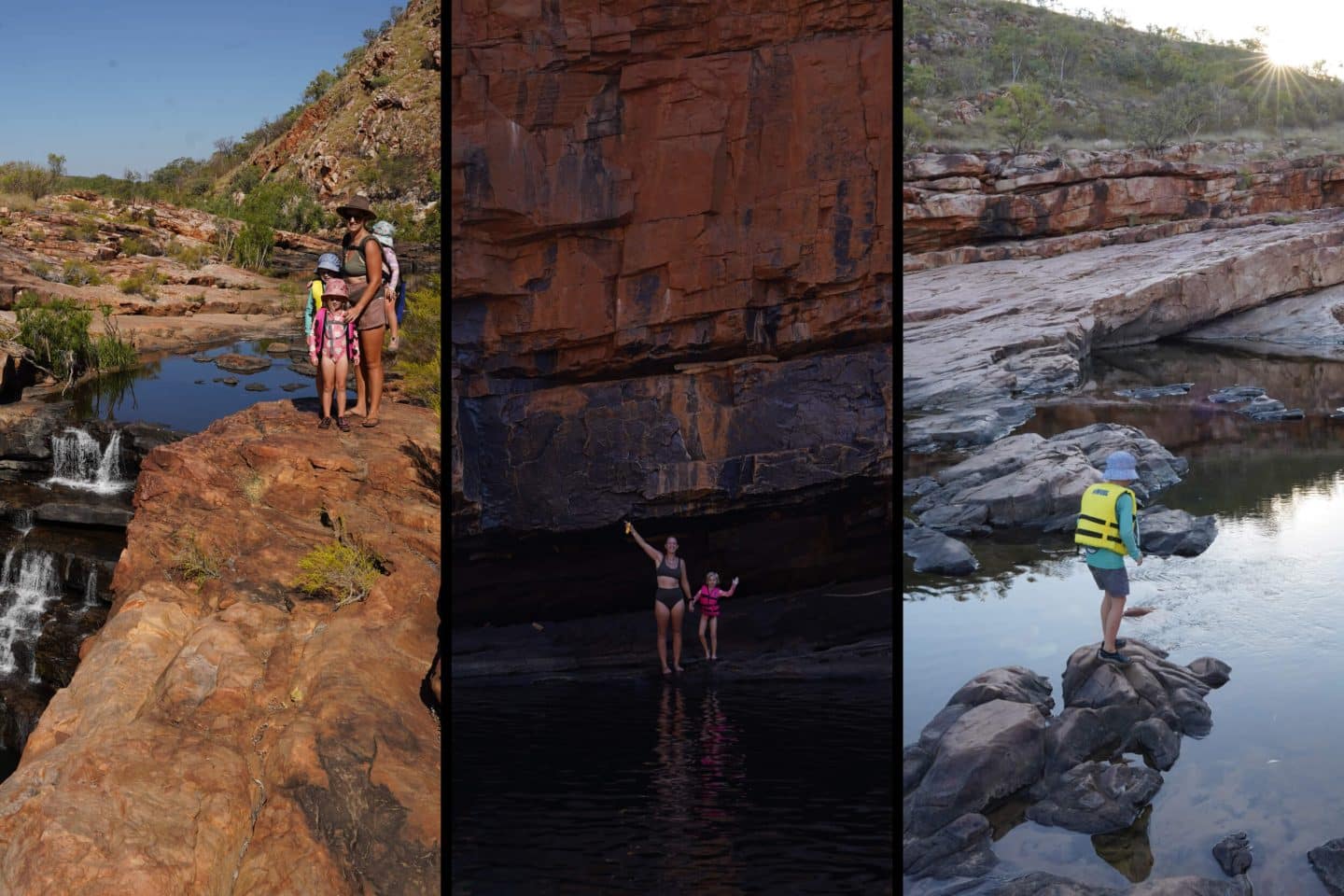
Day 6 – March Fly Glen to Manning Gorge Campground (96 km)
Get back on the road and make a quick stop at Imintji Community Store (cheapest diesel on the Gibb.) 3 boxes of sultanas and a box of shapes later you will arrive at Galvins Gorge. A short walk to another stunning multi-level waterfall equipped with a rope swing and some more incredible rock art if you know where to look.. behind the rope swing!
After a refreshing dip it’s back on the road for approximately a ham and cheese sandwich until you arrive at Mt Barnett Roadhouse. Here is where you pay for the camping and gorge fees for Manning Gorge. Spend the afternoon setting up and go for a few sundowners and a swim in the river.
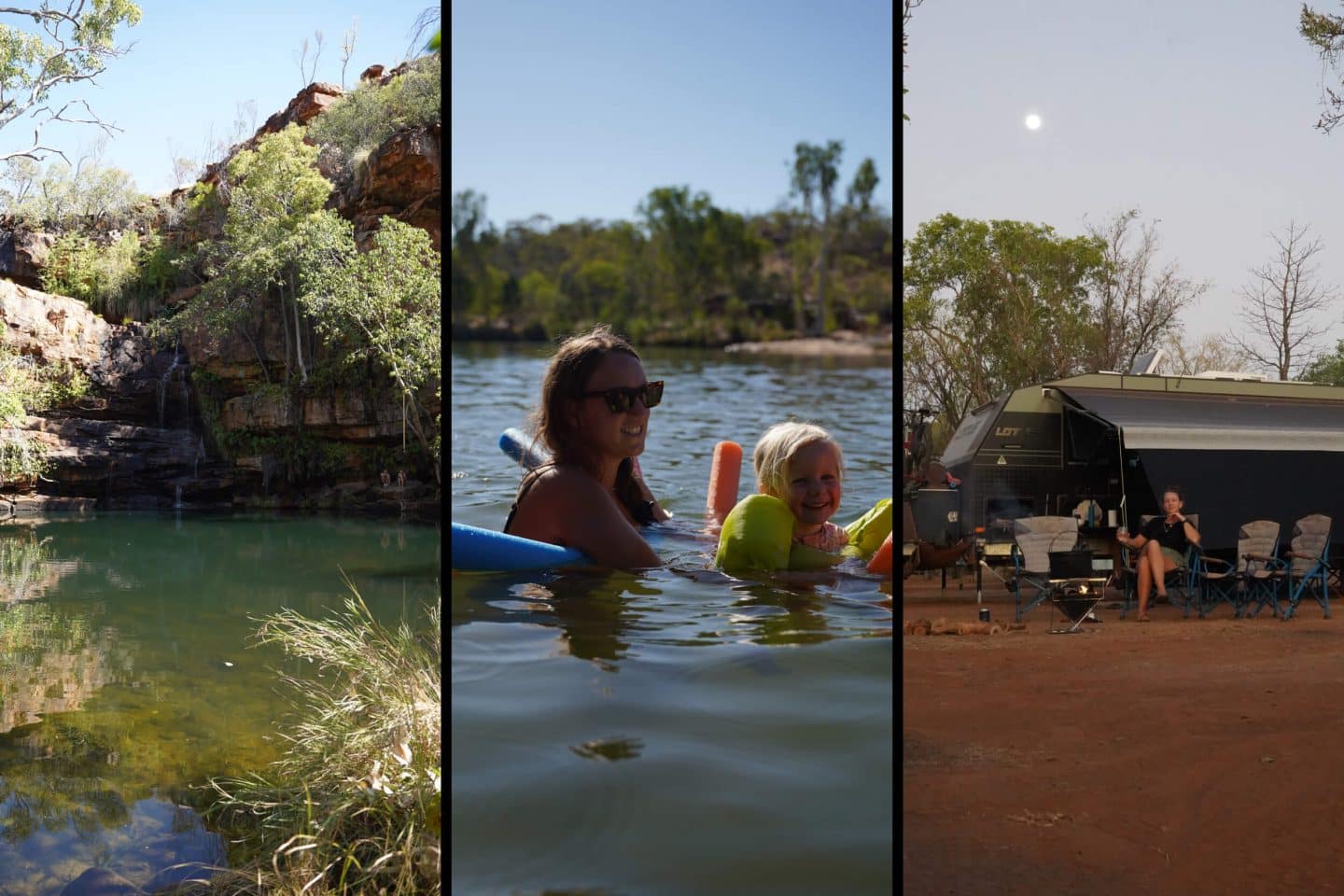
Day 7 – Manning Gorge Walk
It’s a good idea to get up early for this one. Take a packed lunch and plenty of water, as the walk is mostly exposed to the sun and can be very hot. The hike starts with a swim across the river, using the supplied half drums to float your gear and young children across.
It starts off nice and flat with a few gullies to navigate towards the end. The waterfall is a welcome reward and a place you can easily spend a few hours floating around and jumping off the various levels of rock ledge into the water. Getting back to camp is via the same track and the swim through the river is a welcome treat.
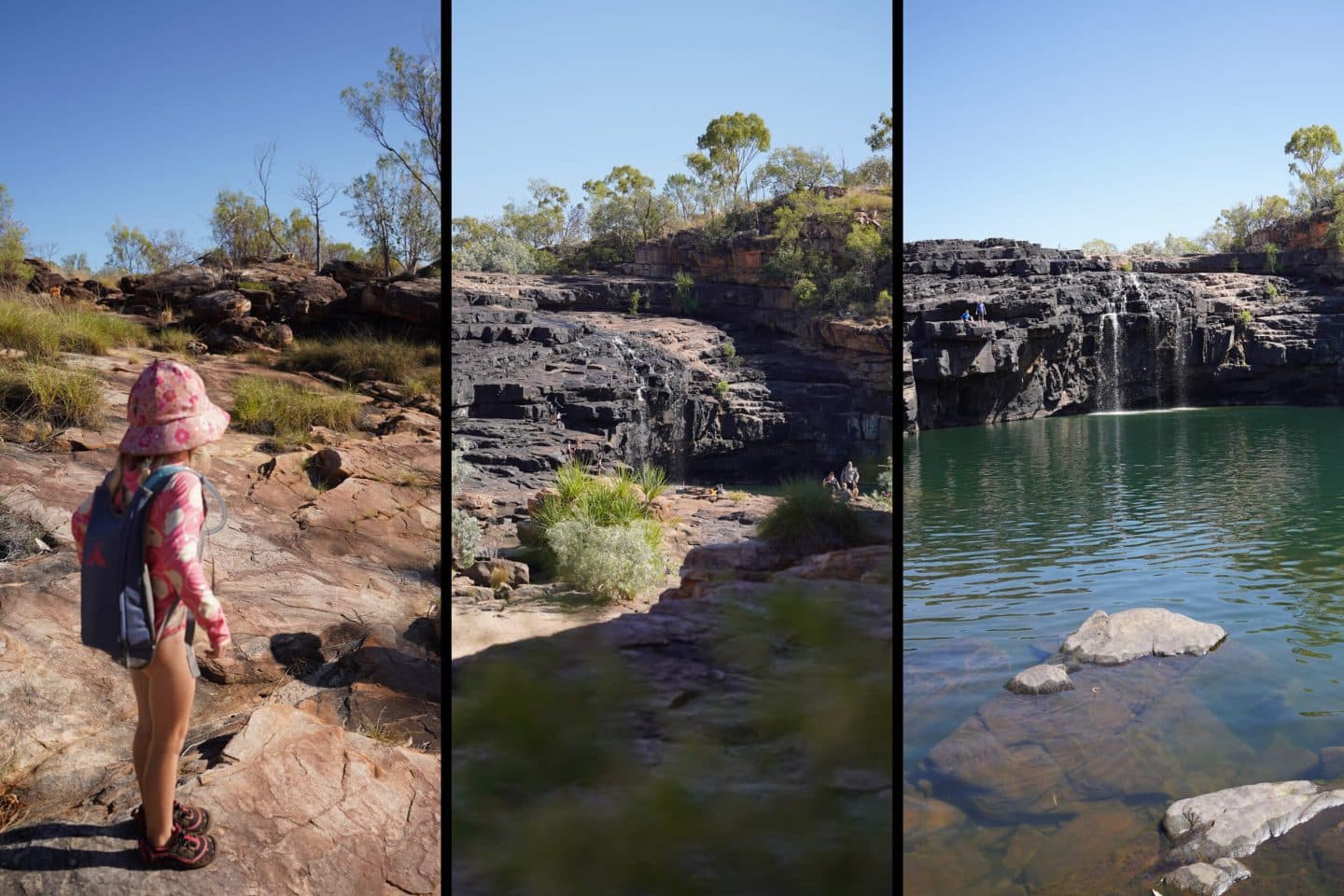
Days 8-9 – Manning Gorge to Gibb River Crossing (111 km)
Get on the road again, but not too early.. the roadhouse opens at 8.30 am.
Fuel up, Top up water, and grab any supplies you may need from here, it’s pricey but they have a good range of food and bits and pieces to get you out of trouble.
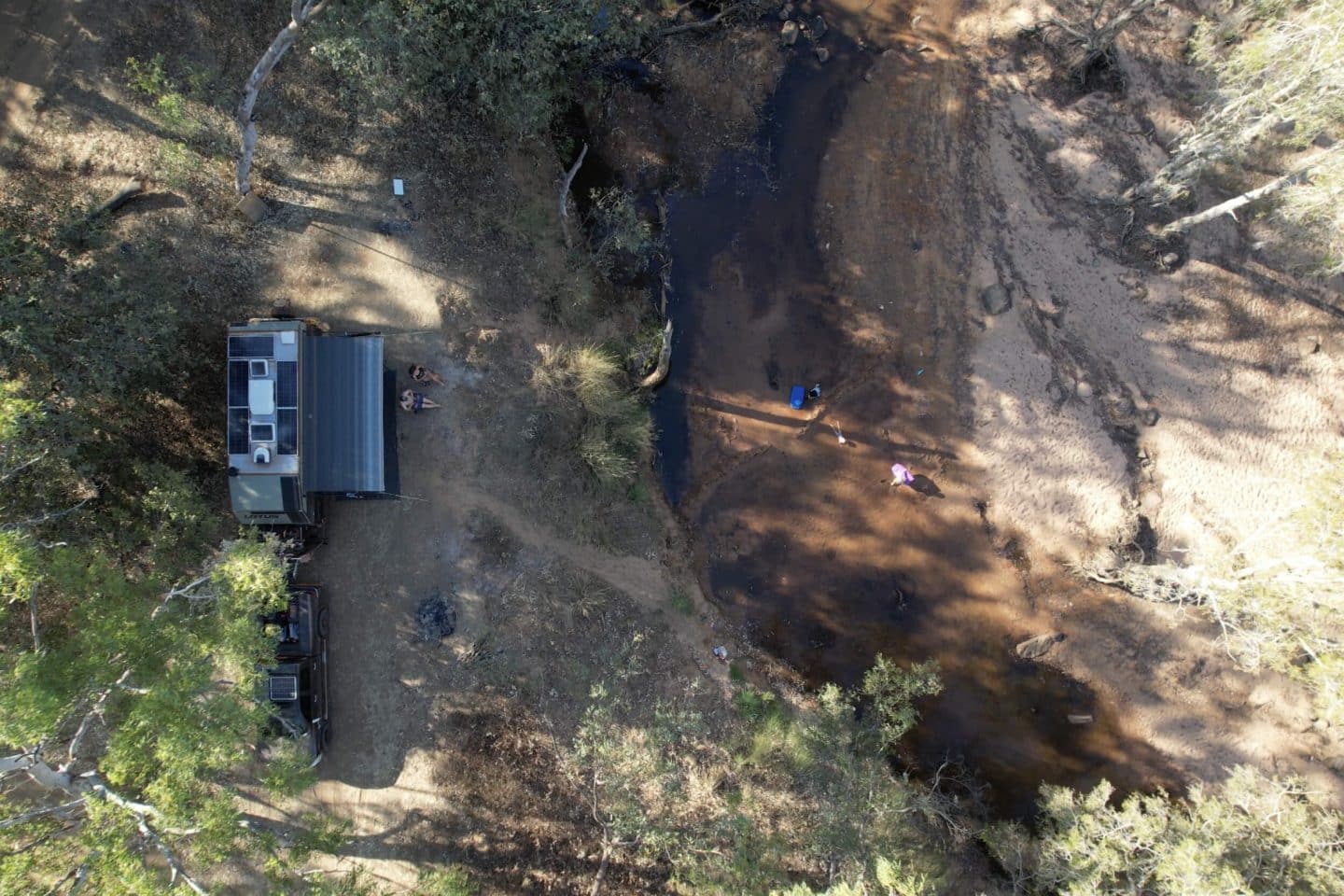
The Gibb River crossing is a free camp, and it pays to get here early if you want a good spot close to the water. We were about 12 steps from the river with our own private beach! The kids had a blast here; the water is shallow but on the upstream side of the crossing it is deep with a rock ledge to jump in. We recommend staying two nights here to rest from all the hikes, and prepare for the hikes to come.
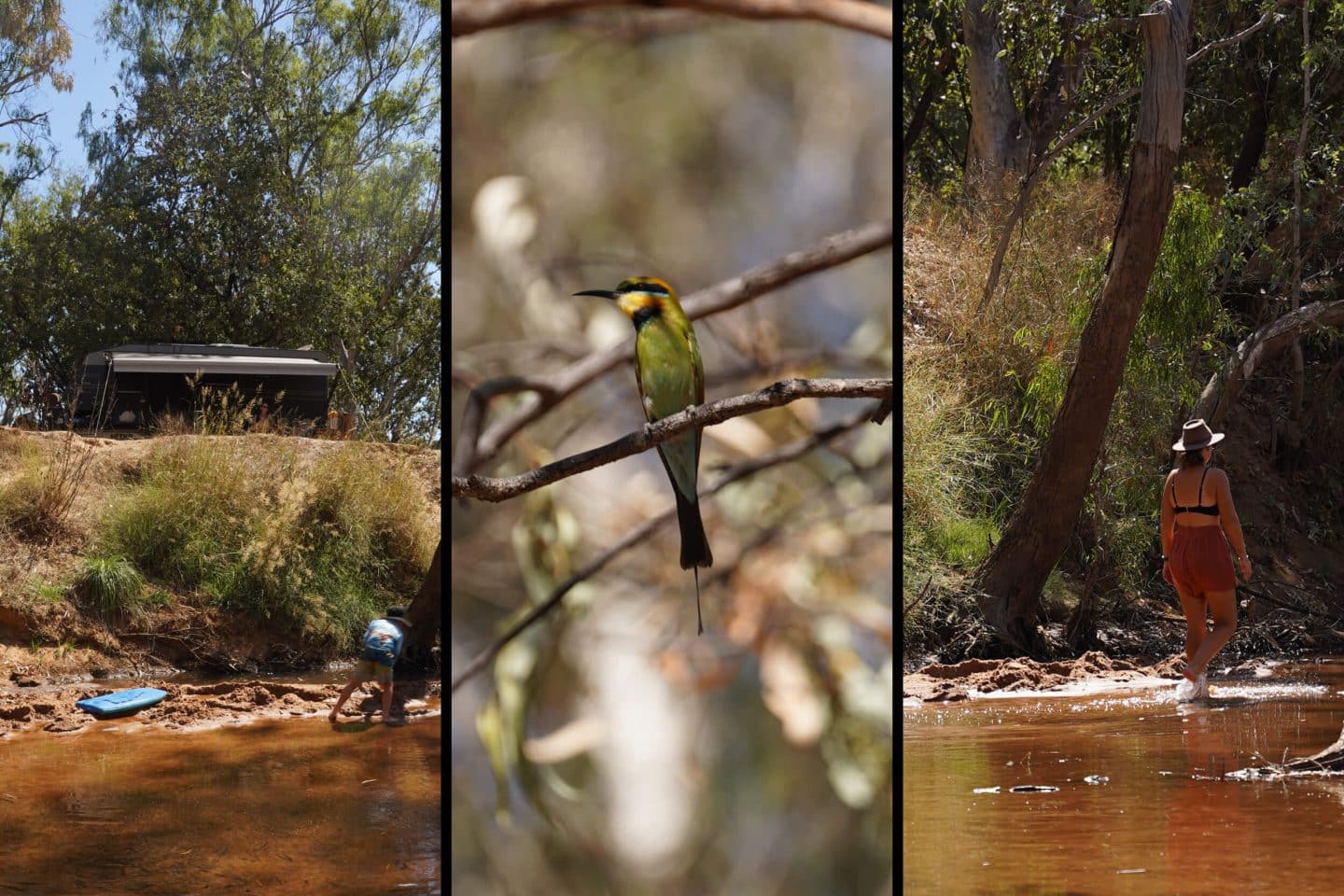
Day 10 – Gibb River Crossing to El Questro (226 km)
First stop today after 77 km is Ellenbrae Station, home of the famous scones! A quick run around for the kids and it’s back out to the main road again for some window scenery, up and over a few ranges and you will soon get a glimpse of the Cockburn Ranges, and eventually, the Pentecost River Crossing! A sight to behold and also the end of the gravel on the Gibb. But the adventure isn’t over yet! Just down the road is El Questro Station!
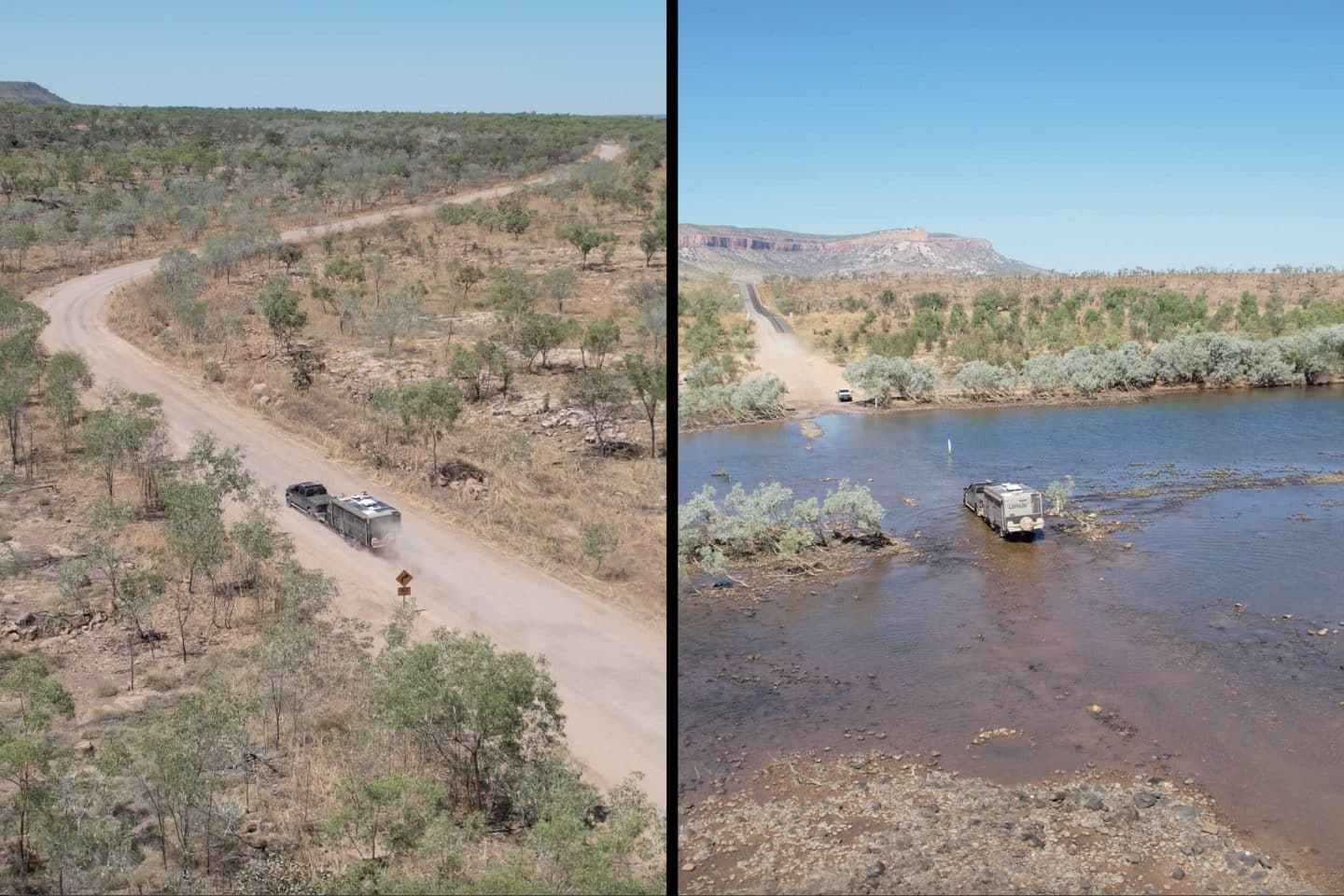
Day 11 – El Questro Gorge Hike
El Questro Station is a destination in itself. There is no shortage of things to do here, from rocky 4×4 tracks, sunset lookouts, river cruises, horse riding and helicopters to name just a few. But for us, the main reason is the numerous hikes and swimming holes.
A short drive from camp brings you to the El Questro Gorge track, and one of your first critical decisions of the day.. Do I drive across the river crossing?? In our case, it was an easy yes! The crossing barely touched the side steps of the Ram, but the level changes throughout the seasons and the depth is well sign posted. The trail carpark is approximately 1 km from here.
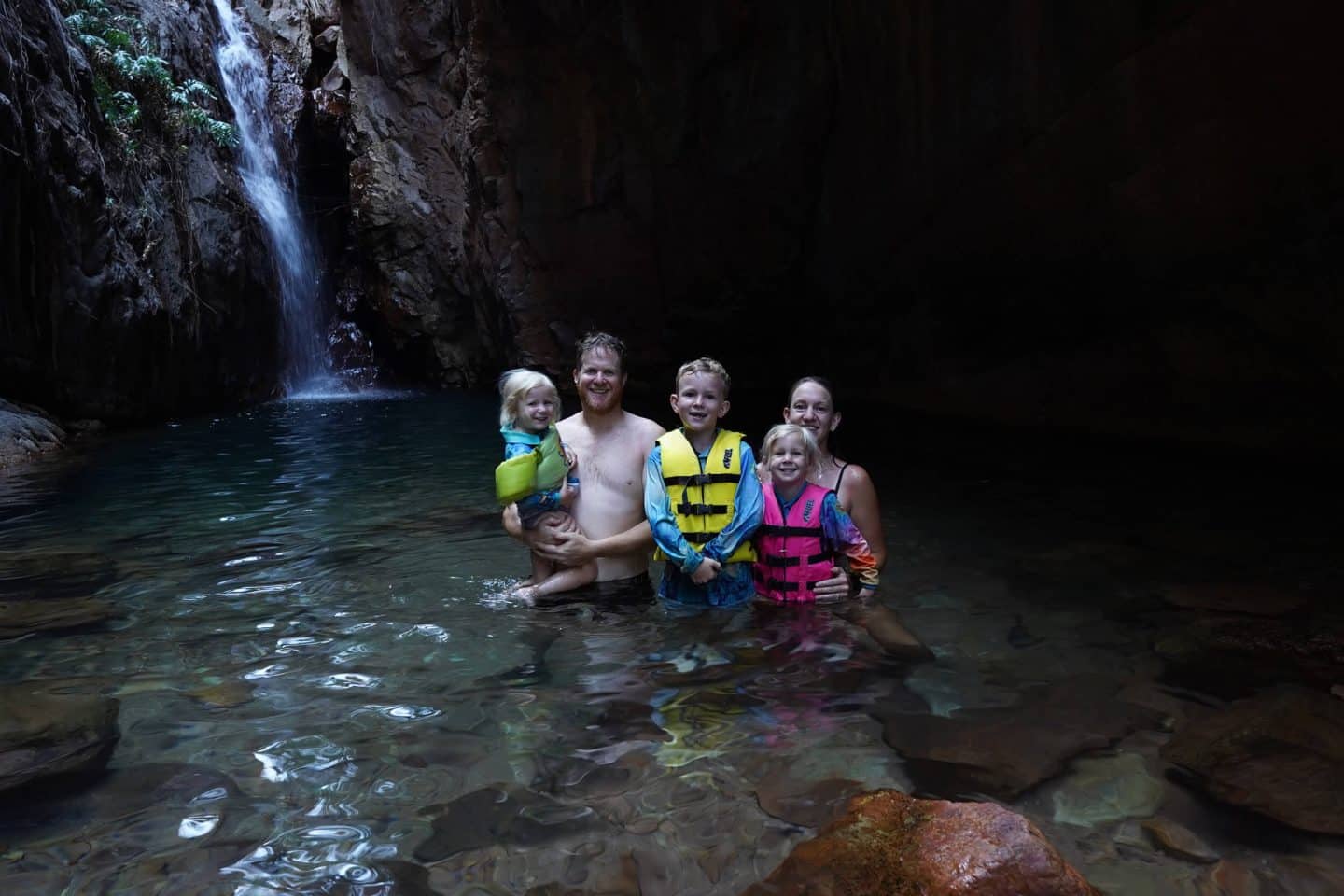
The second critical decision of the day is, will I keep going past the middle pool? It’s a tough slog with young kids, but absolutely worth it in my opinion! We spent most of the day doing this challenging hike with an hour spent soaking it in.
Day 12 – Zebedee Springs and Emma Gorge
The day after a big hike its always a good idea to have a soak in a hot pool. Luckily, El Questro has you covered! Zebedee Springs is a short walk to warm spring fed pools underneath the shelter of the Livistona Palms. The springs close to the public at 12 pm, so get here early.

Emma Gorge is a short drive up the main road from El Questro, the walk increases in difficulty, but it’s a breeze in comparison to El Questro Gorge. Once you get a glimpse of the impressive waterfall at the end, it’s not a surprise to see how busy it can get. A swim here is refreshing, and much needed before starting the warm hike back to the carpark.
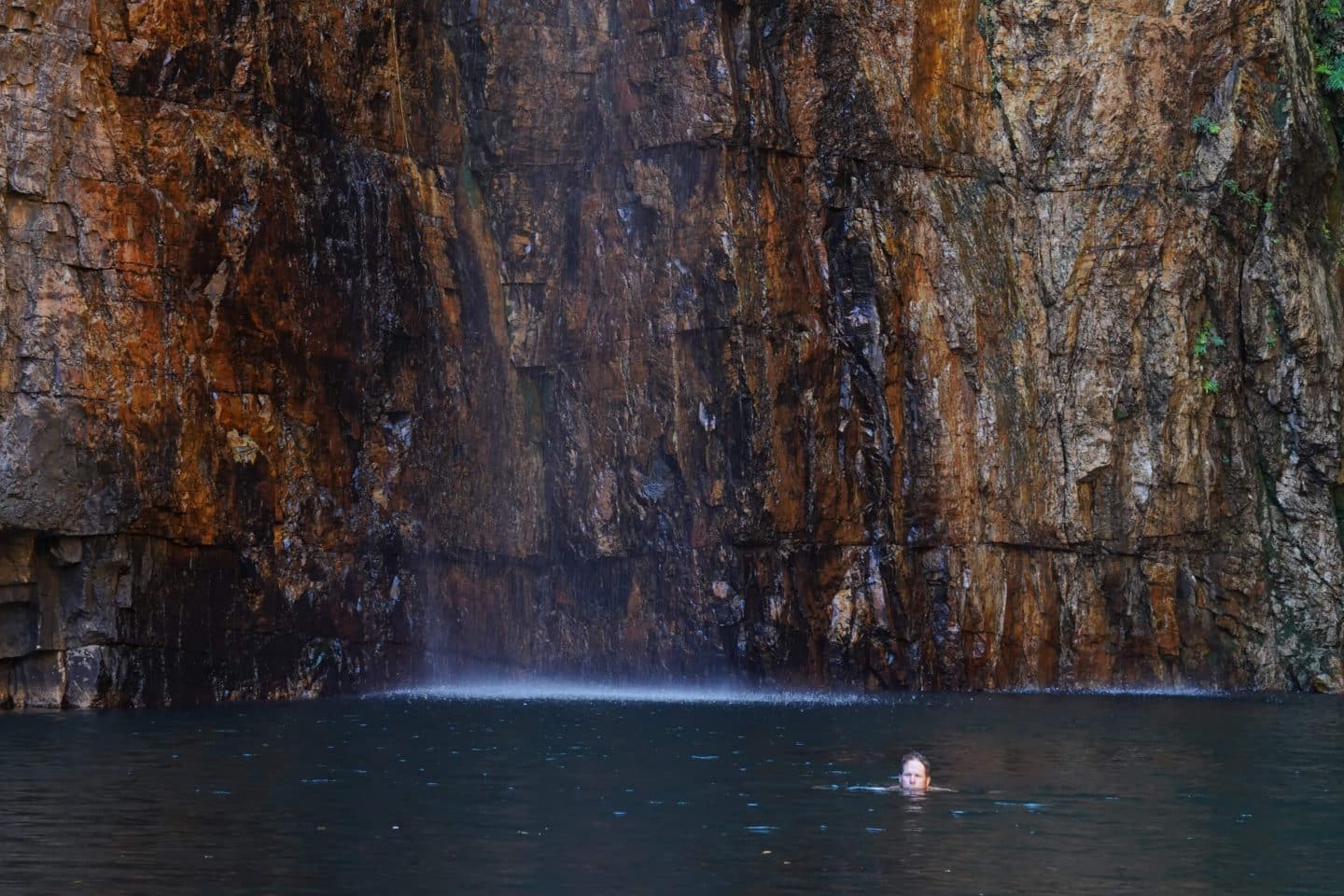
Day 13 – El Questro to Kununurra (103 km)
Time to say goodbye to the Gibb! Inflating the tyres at the main road is a bitter sweet feeling, it’s the end of one of Australia’s best gravel road adventures. But it’s also the point where you’ve run out of food, the laundry is piling up and the dust has formed multiple layers on the paintwork. Time to give it all a wash!
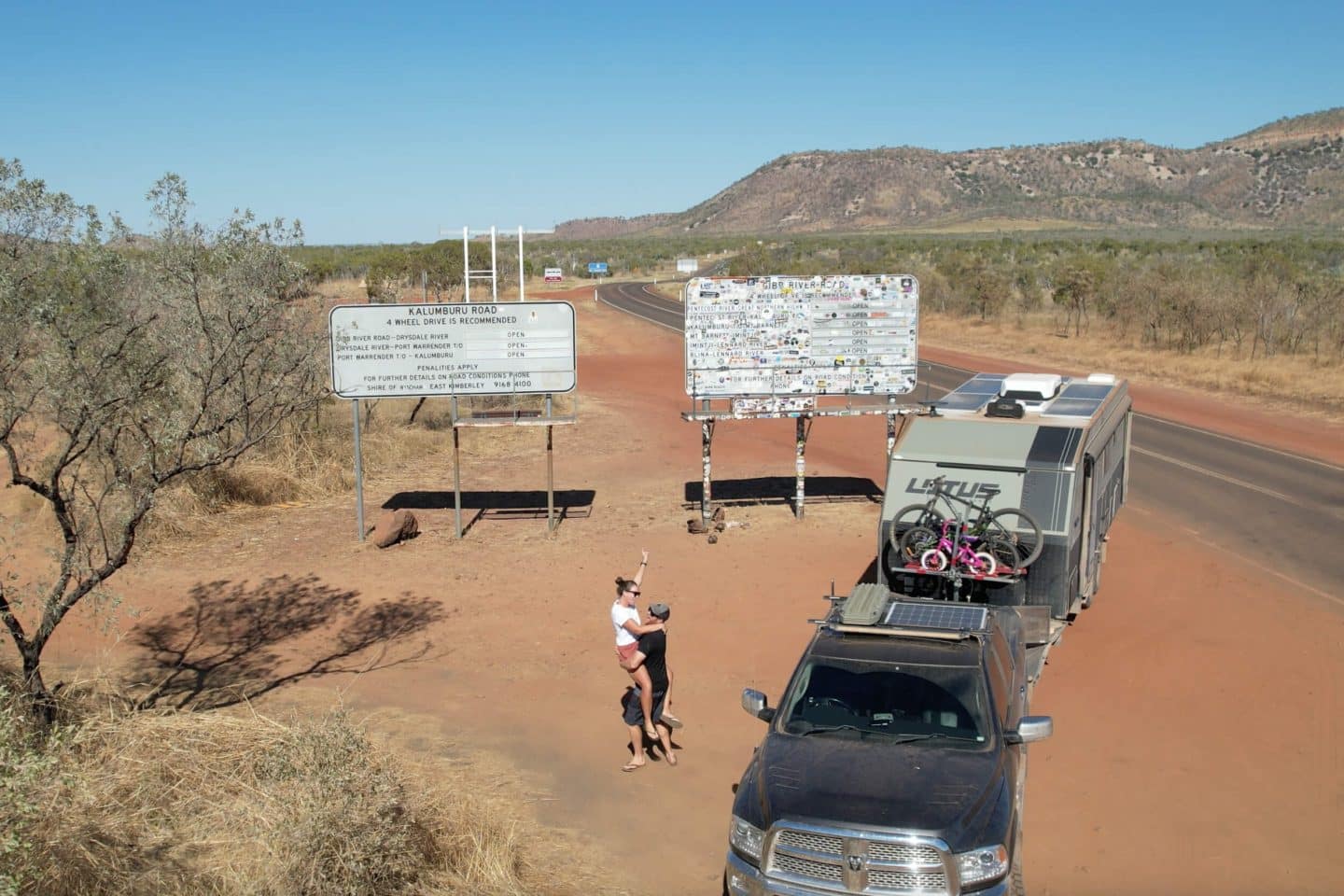
Our Set-Up
The Van
2023 Lotus Trooper 20’9″ Triple Bunk
- Cruisemaster ATX airbag suspension with disc brakes
- 600 AH Lithium with 1000 watt solar
- Enerdrive 2600 watt inverter
- Dometic Dust Reduction System
- 2 x 95l water tanks
The Ram
- 2017 Ram 2500, 6.7L Cummins Diesel
- 2 inch lift with Kings Racing Suspension
- 100AH Lithium with 110 watt solar panel
- Redarc 1240 dc to dc charger
- Dometic CFX 45 fridge/freezer
- Method Race Wheels with 35/12.5/18 Maxxis RAZR A/T’s
You can follow Alloverroamers journeys and discover their incredible caravanning content on their socials –
Instagram – @alloverroamers
Facebook – Alloverroamers
